The Tāne System
10x Faster, No Plastic, No Shock, No Brainer!

The Tane System: A Revolutionary Approach to Large-Scale Native Reforestation Across New Zealand and Beyond
Overview
Ko te whenua te tāonga tuku iho o ngā tūpuna.
E mihi ana ahau ki ngā maunga, ki ngā awa, ki ngā moana e karapoti nei i a tātou.
E mihi ana hoki ahau ki ngā tāngata whenua o tēnei rohe.
Ahakoa nō Ūropi ōku tūpuna,
kei konei ahau e noho ana, e manaaki ana i te whenua.
Ka whakapuaki ahau i taku whakaute ki nga tipuna Maori mo o ratou mohiotanga me o ratou tikanga.
The land is the treasured inheritance from the ancestors.
I acknowledge the mountains, the rivers, and the seas that surround us.
I also acknowledge the indigenous people of this region.
Although my ancestors are from Europe,
I am here, living on and caring for this land.
I express my respect for the Māori ancestors for their knowledge and customs.
This overview presents an innovative, complex and holistic system for reforesting New Zealand that promises to dramatically reduce costs, increase efficiency, and improve environmental outcomes compared to conventional methods. The proposed system leverages several proprietary technologies and processes to streamline seed collection, seedling propagation, and planting at scale known as The Tane System.
Notice to Users:
By accessing this page containing information about The Tane System, you agree to use this information for non-commercial purposes only. While individual elements of the system may be considered general knowledge, the complete Tane System process from seed to tree, as presented here, is proprietary intellectual property. Any unauthorized commercial use, reproduction, or distribution of this complete system is strictly prohibited.
Key Innovations
The Tane System was developed in response to the issues we faced when we took the decision to rewild 20ha of our farm in the heart of The Top of The South Island New Zealand.
Having taken advice it soon became clear that the ‘conventional’ methods of planting were simply not viable. Using the prescribed land preperation and maintainance, 10,000 trees per ha at $3 with an additional tree guard $4 it was calculated to cost almost NZ$2M.
So the quest to find a better way began.
Two years on we have cracked many of the nuts and our innovations combine to form The Tane System:
- Eco-sourced Seed Collection: Utilizing locally adapted plant genetics.
- High-Speed Grow Block Production: Our proprietary prototype hydraulic EarthPress capable of producing 30 soil blocks known as EarthBlocks every 10-20 seconds. Seeds are dispensed into these block via Vac&Drop and the blocks are moved for onward development in our Flood&Drain system.
- Vac&Drop – Precision Seed Sowing: Our proprietary vacuum plate system ensures accurate seed placement in the EarthBlocks.
- Flood&Drain Optimized Seedling Growth: Our proprietary flood and drain system ensures robust root development and nutrient delivery.
- The EarthShield (Patent Pending) Paper Pot and Guard: Biodegradable combined paper pot and seedling guard. Our proprietary EarchShield infused with fertilizers and animal repellents serves as both container and plant guard, eliminating plastic waste and expensive alternatives.
- Drill&Drop – Streamlined Planting Process: Drilling with powerful hand held augers are significantly faster than traditional methods. Furthermore the method reduces planter stress on the body allowing workers to work better. Simply drill a small hole and drop in the EarthShield.
- No Transplant Shock: Eliminates transplant shock from both the pricking out, potting on and planting stages.
- Tagasaste as a Pioneer: The use of this ‘wonder tree’ as a resolution for many of the issues faced in establishing first stage canopy.
- Bio-Char: Our proprietary prototype Bio-Char kiln makes Bio-Char from forestry waste and slash for carbon sequestration in the growing medium.
Comparative Analysis
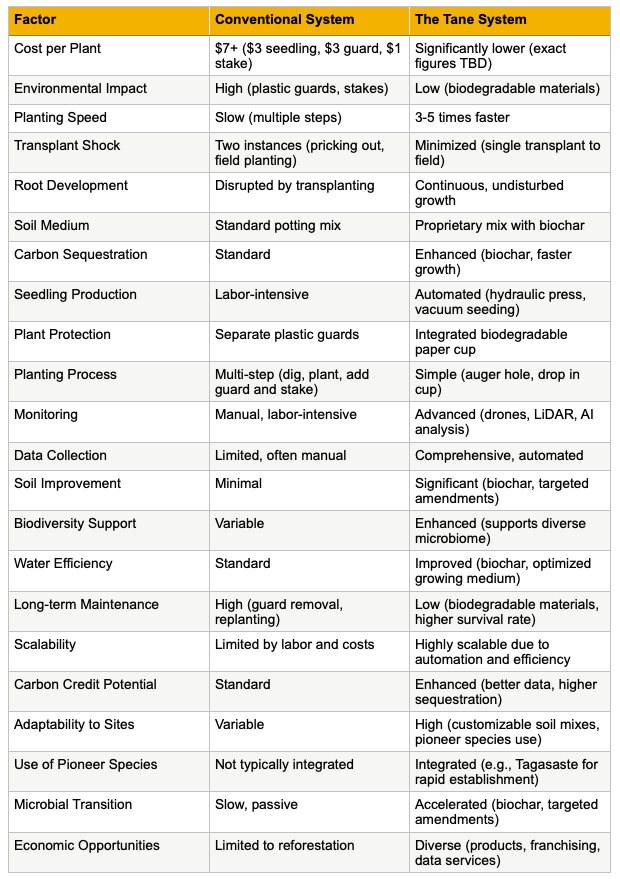
The Numbers
Propagation Cost Comparison for 1 hour labour @ $30/hour
Tane System $1.43
Soil Block Pressing
- 30 blocks / 20 seconds = 90 blocks/minute = 5400 blocks/hour
Seed Sowing
- Assuming it takes the same amount of time to remove blocks and sow seeds as to press blocks (20 seconds), the effective seed sowing rate is also 30 seeds/20 seconds = 90 seeds/minute = 5400 seeds/hour.
Total Cycle Time
- Pressing and sowing one batch of 30 blocks/seeds takes 40 seconds.
- Number of cycles per hour: 60 minutes/hour * 60 seconds/minute / 40 seconds/cycle = 90 cycles/hour
Total Trees Produced
- 90 cycles/hour * 30 trees/cycle = 2700 trees/hour
Labor Cost Per Tree
- $30/hour / 2700 trees/hour = $0.01/tree
Transfer to EarthShield
- Transfer time: 2 seconds/tree
- Trees transferred per minute: 60 seconds/minute / 2 seconds/tree = 30 trees/minute
- Trees transferred per hour: 30 trees/minute * 60 minutes/hour = 1800 trees/hour
- Labor cost per tree: $30/hour / 1800 trees/hour = $0.02/tree
Planting Labour Cost
- Tane planting: $0.15/tree
Total labour per tree planted: 18c
Materials:
EarthShield: $1.00
Stake: 10c
- TOTAL COST/TREE IN THE GROUND: $1.43
- TREES PLANTED/HOUR 300-350
Standard System $7.85
Sowing:
- Seeds sown per minute: 60 seconds/minute / 2 seconds/seed = 30 seeds/minute
- Seeds sown per hour: 30 seeds/minute * 60 minutes/hour = 1800 seeds/hour
- Labor cost per seed: $30/hour / 1800 seeds/hour = $0.02/tree
Transfer to Root Trainer
- Transfer time: 3 seconds/tree
- Trees transferred per minute: 60 seconds/minute / 3 seconds/tree = 20 trees/minute
- Trees transferred per hour: 20 trees/minute * 60 minutes/hour = 1200 trees/hour
- Labor cost per tree: $30/hour / 1200 trees/hour = $0.03/tree
Planting Labour Cost
- Standard planting: $1/tree
Total labour per tree planted: $1.05c
Materials:
Germination Tray: $1.50
Root Trainer: $1.50
Tree Guard: $2.50
Stake: 30c
- TOTAL COST/TREE IN THE GROUND: $7.85
- TREES PLANTED/HOUR 30-50
Comparison Table: Tane System vs. Standard System
Note: This table is based on the provided data and assumptions. Actual results may vary due to factors such as seedling survival rates, growth rates, and labor efficiency.
Analysis
The Tane system demonstrates significantly higher productivity and lower labor costs per tree compared to the standard system. However, the standard system might offer advantages in terms of seedling quality and adaptability to different plant species.
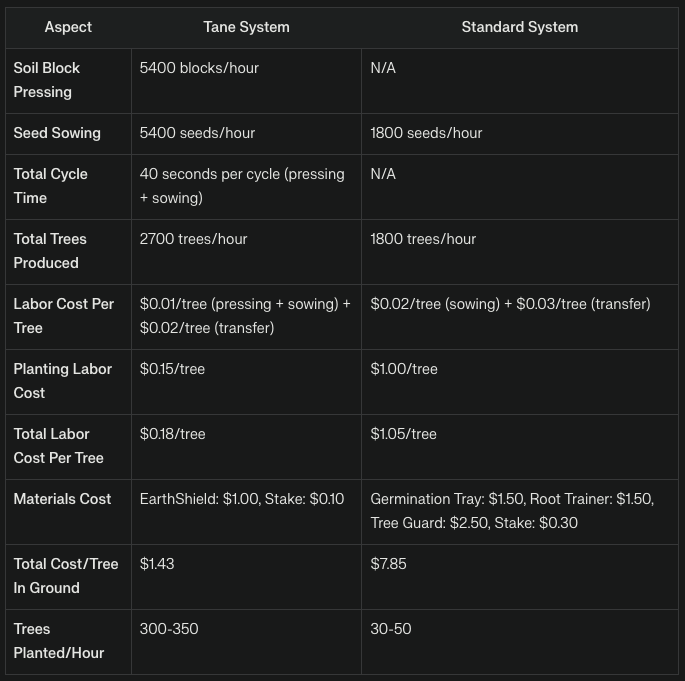
Planting per Ha
The Timata Method:
- Spacing 1500/ha 3M spacing
- Pioneer species: Kanuka Manuka
- No guards
- Video https://youtu.be/p8KHO4W–5E
- Cost offset with honey
The Tane System:
To plant a hectare (ha) at 1.5m spacing:
- Understand the area: 1 hectare = 10,000 square meters (100m x 100m)
- Calculate the number of trees along each side: 100m· 1.5m = 66.67 trees Round up to 67 trees per side (to ensure full coverage)
- Calculate the total number of trees: 67 x 67 = 4,489 trees
Here’s a comparison of the costs and speed for the Standard System and the Tane System, assuming a planting density of 4,450 trees per hectare:

Analysis:
Cost Efficiency:
The Tane System is significantly more cost-effective, with a total cost per tree of $1.43 compared to $7.85 for the Standard System. This results in a total cost of $6,363.50 to plant 4,450 trees using the Tane System, compared to $34,892.50 using the Standard System.
Speed and Labor Efficiency:
The Tane System allows for 300-350 trees to be planted per hour, which is much faster than the 30-50 trees per hour achievable with the Standard System. This means that planting 4,450 trees would take approximately 12.7 to 14.8 hours with the Tane System, whereas it would take 89 to 148 hours with the Standard System.
Summary
- Cost Efficiency: The Tane System is approximately 81.8% more cost-effective than the Standard System.
- Speed Efficiency: The Tane System is approximately 712.5% faster than the Standard System.
System Components and Process
1. Seed Collection: Gather eco-sourced seeds to maintain local genetic diversity.
2. EarthBlock Production: Use the proprietary hydraulic press to create soil blocks with seed indentations.
3. Vac&Drop Precision Seeding: Employ the vacuum plate system for accurate seed placement in soil blocks.
4. Seedling Propagation: Utilize flood and drain tables with a proprietary fertilizer mix to promote strong root growth.
5. EarthShield: Transfer seedlings to the Patented EarthShield.
6. Drill&Drop Field Planting: Use an auger to create holes and simply drop in the entire paper cup with the seedling.
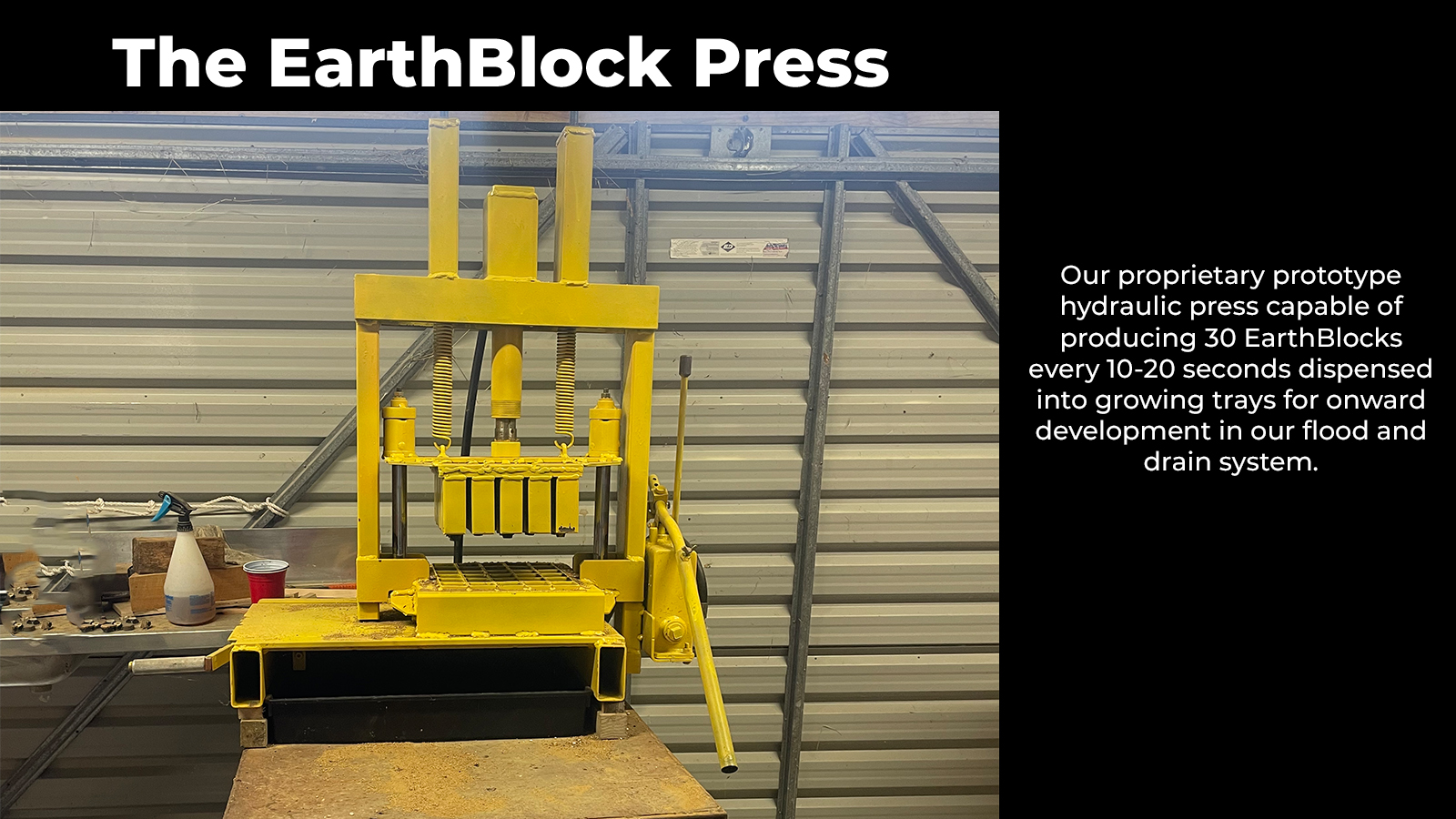
Soil Blocks vs. Pricking Out
| Aspect | Soil Blocks | Pricking Out |
|---|---|---|
| Plant Health | Better root development due to air pruning; less root disturbance | Potential root damage during transplanting; may lead to stunted growth |
| Production Speed | Faster; fewer steps (make blocks, plant seeds, transplant blocks) | Slower; more steps (sow seeds, prick out, transplant) |
| Labor Efficiency | More efficient; no need for pricking out step | Less efficient; requires careful handling during pricking out |
| Transplant Shock | Minimal to no transplant shock | Higher risk of transplant shock due to root disturbance |
| Cost | Initial investment in soil blocker; long-term savings on containers | Ongoing costs for seed trays and pots |
| Material Savings | Reduces or eliminates need for plastic containers | Requires seed trays and pots for each stage |
| Space Efficiency | More plants per square foot; stackable | Less space-efficient; trays take up more room |
| Watering Needs | May require more frequent watering | Generally requires less frequent watering |
| Root Development | Promotes stronger, more fibrous root systems | Can lead to circling roots if left too long in containers |
| Sustainability | More eco-friendly; reduces plastic waste | Less sustainable due to reliance on plastic containers |
| Flexibility | Can easily “pot up” by using larger soil blocks | Requires new containers for each stage of growth |
| Soil Mix | Requires specific soil blocking mix | Can use standard potting soil |
| Learning Curve | Steeper initial learning curve to master technique | Familiar method for most gardeners |
| Plant Variety Suitability | Excellent for most plants, especially those sensitive to root disturbance | Some plants may not transplant well using this method |
Environmental Benefits
- Elimination of plastic plant guards and bamboo stakes
- Recycling of cardboard waste into paper cups
- Reduced transportation costs due to more efficient planting process
- Improved seedling survival rates due to minimized transplant shock
- Improved Carbon sequestration with Bio-Char
The Tane System system offers significant environmental advantages over conventional methods:
Elimination of Plastic Waste
The recycled, biodegradable paper cups that double as plant guards eliminate the need for plastic or plastic/wax coated paper guards, which are a major source of environmental pollution in traditional reforestation efforts. Plastic guards can take hundreds of years to decompose and often end up as microplastics in soil and water systems.
Reduction of Non-Biodegradable Materials
By removing the need for bamboo stakes, the system further reduces the introduction of non-native materials into reforestation sites. While bamboo is biodegradable, it’s often not native to the planting areas and can take several years to decompose.
Recycling and Circular Economy
The use of recycled cardboard waste in the production of paper cups promotes a circular economy approach. This not only reduces landfill waste but also decreases the demand for virgin paper materials, potentially saving trees and reducing the carbon footprint associated with paper production.
Improved Soil Health
The biodegradable paper cups, gradually break down and enrich the soil around the seedling. This is further enhanced with the use of Bio-Char. This slow-release approach can improve soil structure and nutrient content over time, benefiting not just the planted seedling but the surrounding ecosystem as well.
Reduced Carbon Footprint
The streamlined planting process, being 3-5 times faster than traditional methods, significantly reduces the time and resources required for large-scale reforestation projects. This efficiency translates to lower fuel consumption for transportation and machinery operation, thereby reducing the overall carbon footprint of the reforestation process.
Enhanced Biodiversity
The use of eco-sourced seeds promotes genetic diversity and helps maintain the integrity of local ecosystems. This approach supports the development of resilient forests that are better adapted to local conditions and more resistant to pests and diseases.
Water Conservation
The flood and drain system used in seedling propagation encourages deeper root growth, potentially resulting in plants that are more drought-resistant. This could lead to improved survival rates and reduced need for irrigation in the early stages of forest establishment.
Minimized Ecosystem Disruption
The simplified planting process, which involves only drilling a small hole and inserting the paper cup, minimizes soil disturbance compared to traditional methods. This can help preserve existing soil structure and microorganisms, leading to healthier forest ecosystems in the long term.
By addressing multiple environmental concerns simultaneously, this innovative reforestation system represents a significant step forward in sustainable forest restoration practices. Its holistic approach not only aids in the immediate goal of reforestation but also contributes to broader environmental conservation efforts.
7x Faster, Stronger, Healthier Trees: The EarthShield Advantage
Traditional reforestation methods typically involve multiple transplanting stages, each introducing significant stress to seedlings:
- Pricking out seedlings from initial germination trays
- Transplanting into larger containers for further growth
- Final planting in the field
Each of these steps causes transplant shock, disrupting root systems and stunting growth. This shock can lead to higher mortality rates and slower establishment in the field.
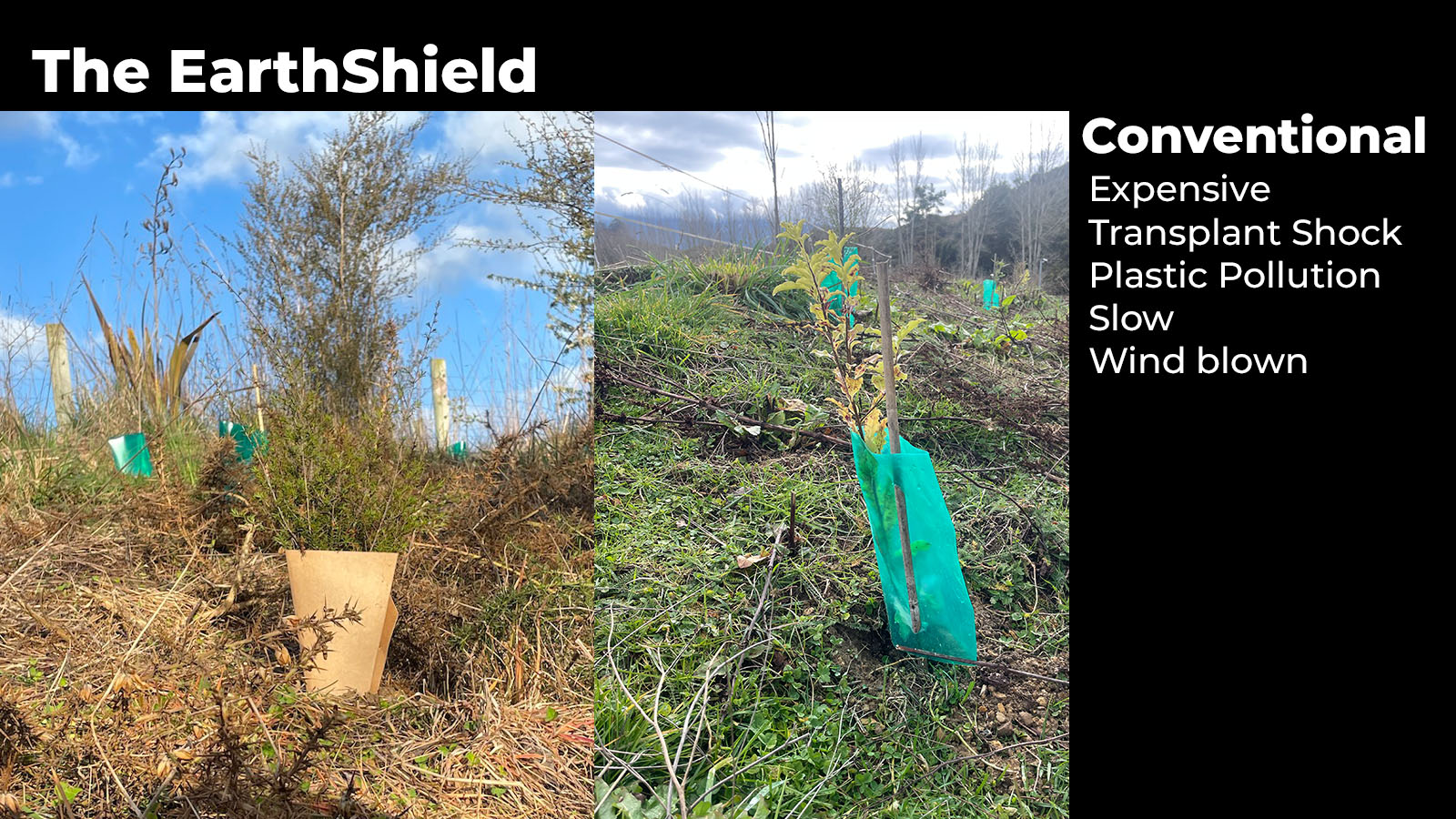
The Tane System’s innovative EarthShield(Pat) approach revolutionizes this process:
- Seeds are germinated in our EarthBlocks and dropped directly into the EarthShield
- Seedlings develop undisturbed in the EarthShield from germination to field planting
- The entire EarthShield is planted in the field, eliminating the need for bare-root transplanting
This streamlined method offers several key benefits:
- Continuous, Uninterrupted Growth: Seedlings develop without disturbance, resulting in stronger, more resilient plants.
- Enhanced Root Development: The uninterrupted growth allows for deeper, more extensive root systems.
- Reduced Mortality: Eliminating transplant shock significantly increases seedling survival rates in the field.
- Faster Establishment: Plants adapted to their container environment transition more smoothly to field conditions.
- Improved Long-term Performance: Stronger initial growth leads to better long-term tree health and carbon sequestration potential.
By eliminating multiple instances of transplant shock, The Tane System produces healthier, more robust seedlings that are better equipped to thrive in their final planting locations. This innovative approach not only improves reforestation success rates but also enhances the long-term carbon sequestration potential of each planted tree.
Comparison Table EarthShield Vs Conventional Planting: 7x Faster
| Aspect | EarthShield Planting | Conventional Planting |
|---|---|---|
| Time Efficiency | 10 EarthShields in 3 minutes | 3 minutes per seedling (including laying out materials, planting, adding shield, and staking) |
| Speed | 7x faster | Slower due to multiple steps and components |
| Labor Requirement | Lower labor needs | Higher labor needs |
| Components | Integrated EarthShield | Separate seedling, guard, and stake |
| Setup Time | Minimal | Significant |
| Planting Process | Streamlined | Multi-step |
| Cost Efficiency | Potentially lower due to reduced labor | Higher due to additional materials and labor |
| Scalability | High | Moderate |
| Environmental Impact | Potentially lower due to fewer materials | Higher due to multiple components |
| Suitability for Large Projects | Ideal | Less ideal due to time and labor constraints |
This table highlights the key differences between the EarthShield planting method and conventional planting, emphasizing the efficiency and benefits of using the EarthShield system.
Biochar: Enhancing Soil and Sequestering Carbon
The Tane System incorporates biochar into the seed-growing medium, offering significant environmental benefits and improved plant growth. This addition is inspired by the fertile Amazonian Black Earth (Terra Preta) and represents a cutting-edge approach to carbon sequestration and soil enhancement.

Biochar Production
We have developed a prototype char kiln capable of producing high-quality biochar from organic waste materials and forestry slash. This process not only creates a valuable soil amendment but also helps manage agricultural and forestry residues that might otherwise be burned or left to decompose, releasing greenhouse gases and causing significant flood debris damage.
Soil Enhancement
Biochar, when added to the seed-growing medium, significantly improves soil structure and fertility:
- Increases water retention, reducing irrigation needs
- Enhances nutrient retention, improving fertilizer efficiency
- Promotes beneficial microbial activity in the soil
- Improves soil aeration and root penetration
These benefits lead to stronger, more resilient seedlings that have a higher survival rate when transplanted into the field.
Carbon Sequestration
Biochar represents a powerful tool for long-term carbon sequestration:
- Biochar can persist in soil for hundreds to thousands of years, effectively locking away carbon that would otherwise be released into the atmosphere.
- Studies suggest that biochar can sequester up to 2.2 times its own weight in CO2 equivalent.
- By incorporating biochar into our reforestation efforts, we’re not only growing trees (which themselves sequester carbon) but also storing additional carbon in the soil.
Environmental Impact
The use of biochar in our system offers multiple environmental benefits:
1. Climate Change Mitigation: Each hectare reforested using our biochar-enhanced system could potentially sequester several tons of CO2 equivalent, in addition to the carbon captured by the growing trees.
2. Waste Reduction: Our char kiln can process various organic waste materials, reducing landfill input and methane emissions from decomposing organic matter.
3. Reduced Chemical Inputs: The improved nutrient retention of biochar-enhanced soil can decrease the need for chemical fertilizers, reducing potential runoff and water pollution.
4. Improved Water Management: Enhanced water retention in the soil can reduce erosion and improve watershed health in reforested areas.
5. Biodiversity Support: The improved soil conditions created by biochar can support a more diverse soil ecosystem, potentially enhancing overall biodiversity in reforested areas.
While specific statistics on the impact of biochar in large-scale reforestation projects are still being gathered, preliminary studies show promising results. For example, some research indicates that biochar application can increase plant growth by 20-120% compared to non-amended soils, depending on the type of biochar and plant species.
By incorporating biochar into our innovative reforestation system, we’re not only improving the success rate of our plantings but also contributing to long-term carbon sequestration and soil health. This approach aligns with global efforts to combat climate change and restore degraded landscapes, positioning our system at the forefront of sustainable forest restoration practices.
Soil Microbiology and the Role of Biochar in Forest Restoration
Microbial Differences: Grass Soil vs. Forest Soil
There are significant microbial differences between grass soil and forest soil:
- Diversity: Forest soils typically have higher microbial diversity compared to grassland soils. This diversity is crucial for ecosystem functioning and resilience.
- Fungal Dominance: Forest soils tend to have a higher ratio of fungi to bacteria, while grassland soils are often more bacteria-dominated.
- Mycorrhizal Associations: Forest soils host a greater abundance of mycorrhizal fungi, which form symbiotic relationships with tree roots, enhancing nutrient uptake.
- Organic Matter Processing: Forest soil microbes are adapted to break down more complex organic matter, such as lignin from wood, compared to grass soil microbes.
Biochar’s Role in Supporting Native Forest Seedlings
Biochar can play a crucial role in supporting native forest seedlings and facilitating the transition from grass to forest soil:
- Microbial Habitat: Biochar’s porous structure provides an ideal habitat for beneficial microorganisms, potentially accelerating the development of forest-like soil microbiology.
- Nutrient Retention: Biochar improves nutrient retention, reducing leaching and making essential elements more available to seedlings.
- Water Holding Capacity: Enhanced water retention in biochar-amended soils can help seedlings survive dry periods, crucial for establishment.
- pH Regulation: Biochar can help stabilize soil pH, creating more favorable conditions for forest species adapted to slightly acidic soils.
- Carbon Source: As a stable carbon source, biochar provides a long-term substrate for microbial colonization and activity.
Process of Changing Soil Structure
Transitioning from grass-dominated to forest-dominated soil is a gradual process that can be accelerated by biochar application:
- Initial Application: Incorporate biochar into the existing soil whilst planting forest seedlings.
- Microbial Inoculation: Inoculating the biochar with forest soil microbes or mycorrhizal fungi to jumpstart the microbial transition.
- Organic Matter Addition: Supplement with forest leaf litter or compost to provide additional organic matter typical of forest floors. (See Tagasaste as a pioneer species below)
- Reduced Disturbance: Minimize soil disturbance after planting to allow fungal networks to establish.
- Time and Succession: As trees grow, their leaf litter and root exudates will gradually shift the soil microbial community towards a forest-like composition.
- Monitoring: Regularly assess soil microbial composition and activity to track the transition progress.
By incorporating biochar and following these steps, The Tane System can effectively support the establishment of native forest seedlings and facilitate the transition from grass to forest soil ecosystems. This approach not only enhances seedling survival and growth but also accelerates the development of a self-sustaining forest ecosystem, crucial for long-term carbon sequestration and biodiversity restoration.
Tagasaste: A Pioneer Species for Rapid Forest Establishment
Tagasaste (Chamaecytisus palmensis), also known as tree lucerne, has emerged as a remarkable pioneer species in our reforestation efforts. Field tests have demonstrated its exceptional qualities, making it a valuable component of The Tane System’s approach to accelerating forest establishment.
Furthermore, our neighbouring farm has established mature and diverse native forest from stock grazed land with the strategic use of Tagasaste as a proof of concept.
A substantial Tagasaste plantation is now sown on our farm and will provide millions of seeds per year by late 2025/26.
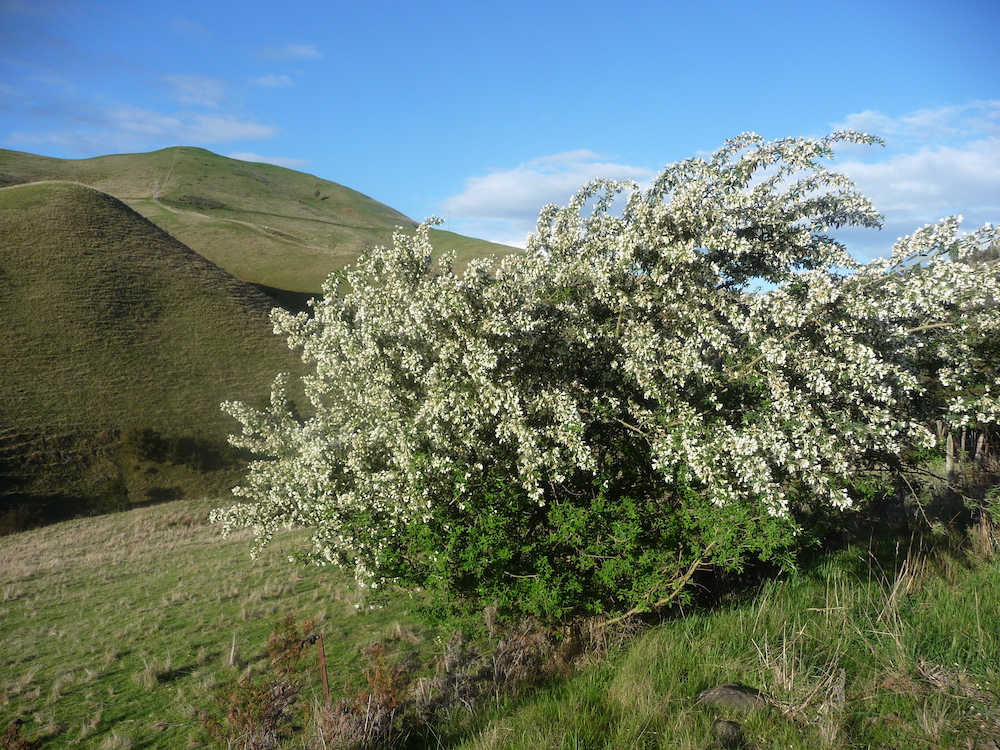
Rapid Growth and Canopy Formation
- Tagasaste exhibits extraordinary growth rates, reaching up to 3 meters in height within a single year.
- This rapid growth allows for quick canopy formation, essential for:
- Shading out competing grass species
- Creating a forest-like microclimate
- Protecting slower-growing native seedlings
Nitrogen Fixation
- As a legume, Tagasaste fixes atmospheric nitrogen into the soil.
- This natural fertilization process:
- Enriches soil fertility
- Supports the growth of other plant species
- Accelerates the transition from grass-dominated to forest-like soil conditions
Attracting Seed-Dispersing Birds
- Tagasaste flowers attract a variety of bird species.
- These birds play a crucial role in forest regeneration by:
- Dropping seeds of native species beneath the Tagasaste canopy
- Enhancing biodiversity without additional planting efforts
- Creating natural seed dispersal patterns typical of established forests
Biomass Production for Soil Microbial Transition
- The substantial biomass produced by Tagasaste contributes significantly to soil improvement:
- Leaf litter and root exudates feed soil microorganisms
- Accelerates the shift from grass-associated to forest-associated microbial communities
- Enhances soil structure and organic matter content
Adaptability to Grassland Conditions
- Tagasaste’s ability to establish and thrive in grass-dominated areas makes it an ideal transition species:
- Competes effectively with existing grass cover
- Tolerates a wide range of soil conditions
- Helps prepare the site for less hardy native species
Short Lifespan and Sustainable Management
- The relatively short lifespan of Tagasaste (typically 15-20 years) is advantageous for forest succession:
- Naturally gives way to longer-lived native species over time
- Allows for planned replacement with target forest species
- Provides a timeframe for the establishment of slower-growing natives
Additional Benefits
- Excellent Firewood: As Tagasaste is gradually replaced by native species, it provides a valuable source of firewood, offering an economic incentive for landowners.
- Erosion Control: Its deep root system helps stabilize soil on slopes and in erosion-prone areas.
- Fodder Potential: In some management scenarios, Tagasaste can be used as high-protein fodder for livestock, providing additional land-use options during the transition phase.
By incorporating Tagasaste as a key pioneer species, The Tane System leverages its rapid growth, nitrogen-fixing capabilities, and ecological functions to accelerate the forest establishment process. This approach enhances the success rate of reforestation efforts and also provides additional benefits in terms of soil improvement, biodiversity enhancement, and potential economic returns.
Economic Advantages
- Significantly lower per-plant costs
- Increased planting speed (3-5 times faster than conventional methods)
- Potential for larger-scale reforestation projects due to reduced costs
The proposed reforestation system offers substantial economic benefits over conventional methods, making large-scale rewilding projects more feasible and cost-effective.
Significantly Lower Per-Plant Costs
Our system dramatically reduces the cost per plant compared to traditional methods:
- Elimination of plastic guards ($3 per plant) and bamboo stakes ($1 per plant)
- Reduced labor costs due to streamlined planting process
- Lower transportation costs as the paper cup system is lighter and more compact
- Decreased need for replanting due to improved seedling survival rates
While exact figures will vary depending on scale and location, preliminary estimates suggest a potential cost reduction of 40-60% per plant.
Drill&Drop Method Increased Planting Speed and Efficiency
The innovative planting process is 3-5 times faster than conventional methods:
- Simplified planting technique (auger hole + drop-in cup) versus multi-step traditional process
- Reduced worker fatigue due to easier planting method, potentially extending workday productivity
- Ability to cover larger areas in shorter timeframes, optimizing labor resources
This increased efficiency translates to significant labor cost savings and allows for more ambitious reforestation targets within given timeframes and budgets.
Economies of Scale in Production
The system’s components offer opportunities for economies of scale:
- High-speed soil block production (30 blocks every 20 seconds) allows for large batch processing
- Automated seed sowing using the vacuum plate system increases accuracy and speed
- Mass production of biodegradable paper cups can reduce per-unit costs
As production scales up, the cost per seedling is expected to decrease further, making large-scale projects increasingly cost-effective.
Reduced Ongoing Maintenance Costs
The system’s design minimizes the need for post-planting interventions:
- Biodegradable cups eliminate the need for guard removal and disposal
- Improved seedling health may reduce the need for replanting or supplemental watering
- Integrated fertilizer and animal repellent in cups decrease the need for additional treatments
These factors contribute to lower long-term project costs and reduced labor requirements for maintenance.
Potential for Larger-Scale Reforestation Projects
The economic efficiencies of this system open up possibilities for more ambitious rewilding efforts:
- Lower per-plant costs allow budgets to stretch further, covering larger areas
- Faster planting speeds enable completion of large projects within shorter timeframes
- Improved seedling survival rates increase the effective coverage per investment
This scalability makes it feasible to undertake landscape-level restoration projects that might have been prohibitively expensive using conventional methods.
Potential for Carbon Credit Revenue
As the system promotes more efficient and successful reforestation:
- Projects may qualify for carbon credits more quickly due to faster establishment and growth
- Improved survival rates could lead to higher carbon sequestration per hectare
- The use of biochar in the growing medium adds an additional carbon sequestration component
This potential for carbon credit revenue could offset land owners project costs or provide additional income streams for landowners and project managers.
Reduced Risk and Improved Project Viability
The system’s efficiencies and improved outcomes reduce financial risks associated with large-scale reforestation:
- Lower upfront costs decrease financial exposure
- Faster completion times reduce vulnerability to changing economic conditions
- Improved survival rates increase the likelihood of project success and associated benefits
This reduced risk profile could make reforestation projects more attractive to investors and funding bodies, potentially increasing available capital for rewilding initiatives.
By significantly reducing costs, increasing efficiency, and improving project outcomes, this innovative reforestation system has the potential to transform the economics of large-scale rewilding efforts. It not only makes existing projects more cost-effective but also opens up possibilities for more ambitious landscape-level restoration initiatives that were previously considered economically unfeasible.
Carbon Credits and Offsets: The Tane System’s Market Potential
Growing Demand for Carbon Offsets
As global efforts to combat climate change intensify, many companies are mandated to become carbon neutral or are voluntarily committing to such goals. This has created a robust and growing market for carbon offsets:
- The global carbon offset market was valued at $270.6 billion in 2022 and is projected to reach $2.4 trillion by 2027, growing at a CAGR of 54.7%.
- In New Zealand, the Emissions Trading Scheme (NZ ETS) provides a framework for carbon trading and offsets.
The Tane System is well-positioned to capitalize on this growing market by offering high-quality, verifiable carbon offsets through its innovative reforestation approach.
The Tane System’s Carbon Sequestration Advantages
- Enhanced Carbon Capture: The system’s use of biochar and optimized growing conditions can lead to faster tree growth and higher survival rates, potentially sequestering more carbon per hectare than traditional reforestation methods.
- Soil Carbon Enhancement: Biochar incorporation not only sequesters carbon directly but also improves soil health, potentially leading to increased long-term carbon storage in the soil.
- Reduced Project Emissions: The efficiency of The Tane System (faster planting, reduced maintenance) means lower operational emissions, increasing the net carbon benefit of each project.
- Verifiable and Measurable Results: The systematic approach allows for precise tracking of planted trees, survival rates, and growth metrics, providing robust data for carbon credit verification.
Carbon Credit Generation Process
- Project Design: Develop reforestation projects using The Tane System, ensuring they meet international carbon credit standards (e.g., Verified Carbon Standard, Gold Standard).
- Baseline Assessment: Conduct thorough assessments of pre-project carbon stocks and projected sequestration.
- Implementation: Execute reforestation using The Tane System’s innovative methods.
- Monitoring and Reporting: Utilize advanced monitoring techniques (e.g., satellite imagery, drone surveys) to track forest growth and carbon sequestration.
- Verification: Engage third-party auditors to verify carbon sequestration claims.
- Credit Issuance: Once verified, carbon credits can be issued and sold on carbon markets.
Market Opportunities
- Corporate Partnerships: Develop direct partnerships with companies seeking to offset their emissions, offering them a stake in specific reforestation projects.
- Carbon Market Sales: Sell verified carbon credits on established carbon markets, including the NZ ETS and international voluntary markets.
- Government Initiatives: Engage with government reforestation programs that may offer additional incentives or preferential treatment for innovative, high-efficiency systems like The Tane System.
- Bundled Services: Offer consulting and implementation services to landowners and organizations looking to generate carbon credits from their land.
Competitive Advantages of The Tane System
- Cost-Effectiveness: Lower implementation costs mean more carbon sequestered per dollar invested, making it an attractive option for offset purchasers.
- Scalability: The system’s efficiency allows for larger-scale projects, appealing to companies with significant offsetting needs.
- Co-Benefits: Beyond carbon sequestration, The Tane System offers additional environmental benefits (biodiversity enhancement, soil improvement) that can increase the value and appeal of the credits.
- Cultural Significance: The system’s name, honoring the Maori mythical character Tane, adds a unique cultural dimension that may be particularly appealing in the New Zealand market and to companies seeking to support indigenous-aligned initiatives.
Verifiable and Measurable Results: Advanced Monitoring with Drone and Mapping Technology
The Tane System leverages cutting-edge drone and mapping technologies to provide unprecedented accuracy in tracking reforestation progress, ensuring robust data for carbon credit verification.
This advanced approach offers several key advantages:

High-Resolution Aerial Imagery
- Drones equipped with high-resolution cameras capture detailed images of reforested areas.
- Regular flyovers (e.g., quarterly or bi-annually) create a time series of aerial photographs.
- These images allow for precise counting of trees, assessment of canopy cover, and early detection of any issues (e.g., disease, pest infestation).
LiDAR Scanning for 3D Mapping
- Drones equipped with LiDAR (Light Detection and Ranging) sensors create accurate 3D models of the forest.
- This technology enables precise measurements of tree height, canopy density, and biomass volume.
- Repeated LiDAR scans over time provide quantifiable data on forest growth and carbon sequestration rates.
Multispectral Imaging for Health Assessment
- Drones with multispectral cameras capture data across various light spectrums.
- This technology allows for early detection of plant stress, disease, or nutrient deficiencies.
- By identifying and addressing issues promptly, The Tane System can maintain higher survival rates and optimal growth.
GPS Mapping for Precise Geolocation
- Each planted area is precisely mapped using GPS coordinates.
- This allows for accurate tracking of the extent of reforested areas and helps in planning future expansions.
- GPS data can be integrated with other datasets for comprehensive analysis.
AI-Powered Image Analysis
- Machine learning algorithms process the collected imagery to automate tree counting and species identification.
- AI can detect changes over time, providing insights into growth rates and forest density evolution.
- This technology significantly reduces the time and labor required for data analysis, allowing for more frequent and comprehensive assessments.
Integration with Climate and Soil Data
- Drone-collected data is integrated with climate station data and soil sensors.
- This holistic approach provides insights into how environmental factors affect forest growth and carbon sequestration rates.
- It allows for more accurate modeling and forecasting of long-term carbon capture potential.
Real-Time Monitoring and Reporting
- Data collected by drones is quickly processed and made available through a cloud-based platform.
- Stakeholders can access up-to-date information on project progress, tree survival rates, and estimated carbon sequestration.
- This transparency builds trust with carbon credit buyers and certification bodies.
Enhanced Verification Process
- The comprehensive data collected through these technologies streamlines the carbon credit verification process.
- Third-party auditors can remotely assess large areas quickly and accurately.
- The wealth of data provides a clear audit trail, reducing the need for extensive on-ground surveys.
Long-Term Tracking and Accountability
- The digital nature of the data allows for long-term storage and analysis.
- Historical data can be easily accessed to demonstrate the project’s progress over decades.
- This long-term tracking is crucial for ensuring the permanence of carbon sequestration, a key requirement for many carbon credit standards.
By incorporating these advanced monitoring technologies, The Tane System sets a new standard for transparency and accuracy in reforestation projects. The ability to provide such detailed, verifiable data not only streamlines the carbon credit certification process but also offers carbon offset buyers unprecedented assurance of the impact of their investments. This technological edge positions The Tane System as a leader in the next generation of nature-based climate solutions, capable of meeting the most stringent requirements of international carbon markets and corporate sustainability programs.
Managing Wilding Pine and Pest Species Control With Ai and Drone Technology
If allowed to spread further, wilding conifers – also called wilding pines – could seriously alter New Zealand’s unique landscapes.
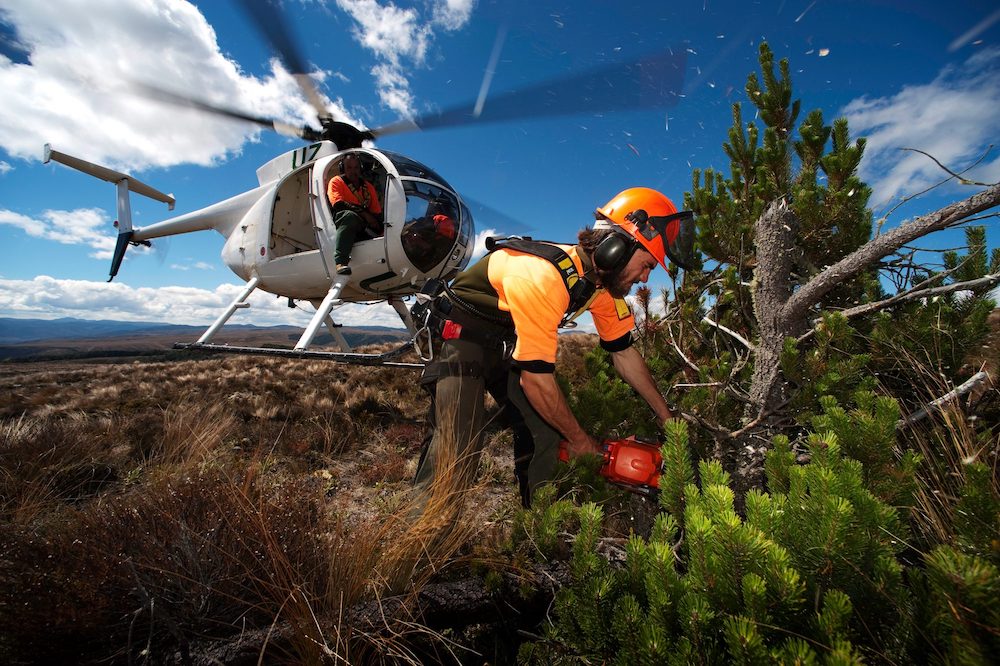
Wilding Pines in New Zealand:
1. Scale of the problem:
- Wilding pines infest over 1.8 million hectares of land in New Zealand, primarily in the South Island[4].
- They pose the biggest threat to New Zealand’s unique environment among plant species[4].
- Without control, wilding pines could cover more than 25% of New Zealand’s land area within three decades[4].
2. Species involved:
There are ten main species of wilding conifers, including:
- Lodgepole pine (Pinus contorta)
- Radiata pine (Pinus radiata)
- Douglas fir (Pseudotsuga species)
- European larch (Larix decidua)
3. Environmental and economic impacts:
- Wilding pines threaten native ecosystems, biodiversity, and productive farmland[2][4].
- They can transform iconic open landscapes, particularly in alpine and high country tussock areas[3].
- The economic cost of wilding pine invasion could reach $4.6 billion due to negative impacts on primary production, biodiversity, hydroelectric power generation, and irrigation[4].
4. Management and Control Efforts:
- In 2020 $100 million was allocated for wilding pine control over four years[3].
- The cost of removing wilding pines increases by 30% every year action is delayed[4].
5. Control methods:
- Mechanical removal (hand pulling seedlings, brush cutters, chainsaws)
- Chemical control (herbicide spraying)
- Ground-based herbicide injection (“drill and fill” technique)[3]
AI Drones for Identification and Spraying:
The Tane Project is developing machine learning algorithms that identify and map weed species to manage and nurture reforested areas:
1. Identification:
- AI-powered drones will be used to survey large areas and identify wilding pine infestations using image recognition technology.
- This will improve the efficiency of mapping and monitoring efforts.
2. Targeted spraying:
- Drones equipped with precision spraying systems will apply herbicides to individual trees or small clusters, reducing overall chemical use and minimizing impact on surrounding vegetation.
3. Cost-effective management:
- Drone technology could potentially reduce labor costs and improve the reach of control efforts in difficult terrain.
In conclusion, wilding pines represent a significant environmental and economic challenge for New Zealand. The country is investing substantial resources in control efforts, with the potential for emerging technologies like Tane AI-powered drones to enhance management strategies in the future.
Citations:
[1] https://en.wikipedia.org/wiki/Wilding_conifer
[2] https://www.wildingpines.nz
Conclusion
This innovative reforestation system has the potential to revolutionize New Zealand’s approach to rewilding and large-scale native forest restoration. By dramatically reducing costs, improving efficiency, and minimizing environmental impact, it offers a promising solution to accelerate the country’s reforestation efforts.
